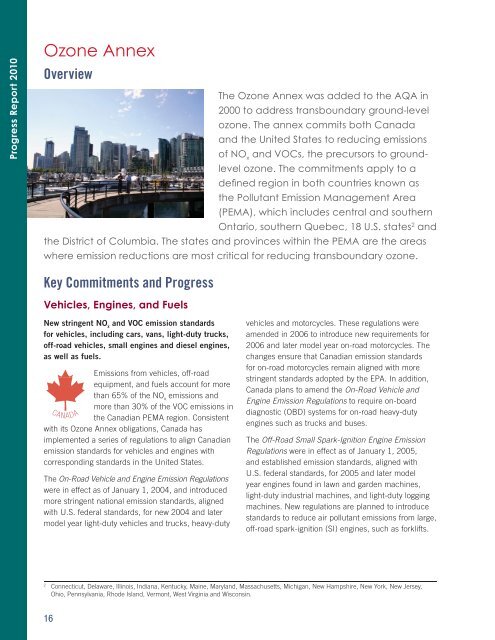2010 Progress Report - International Joint Commission
2010 Progress Report - International Joint Commission
2010 Progress Report - International Joint Commission
Create successful ePaper yourself
Turn your PDF publications into a flip-book with our unique Google optimized e-Paper software.
<strong>Progress</strong> <strong>Report</strong> <strong>2010</strong><br />
Ozone Annex<br />
Overview<br />
The Ozone Annex was added to the AQA in<br />
2000 to address transboundary ground-level<br />
ozone. The annex commits both Canada<br />
and the United States to reducing emissions<br />
of NO x<br />
and VOCs, the precursors to groundlevel<br />
ozone. The commitments apply to a<br />
defi ned region in both countries known as<br />
the Pollutant Emission Management Area<br />
(PEMA), which includes central and southern<br />
Ontario, southern Quebec, 18 U.S. states 2 and<br />
the District of Columbia. The states and provinces within the PEMA are the areas<br />
where emission reductions are most critical for reducing transboundary ozone.<br />
Key Commitments and <strong>Progress</strong><br />
Vehicles, Engines, and Fuels<br />
New stringent NO x<br />
and VOC emission standards<br />
for vehicles, including cars, vans, light-duty trucks,<br />
off-road vehicles, small engines and diesel engines,<br />
as well as fuels.<br />
Emissions from vehicles, off-road<br />
equipment, and fuels account for more<br />
than 65% of the NO x<br />
emissions and<br />
more than 30% of the VOC emissions in<br />
the Canadian PEMA region. Consistent<br />
with its Ozone Annex obligations, Canada has<br />
implemented a series of regulations to align Canadian<br />
emission standards for vehicles and engines with<br />
corresponding standards in the United States.<br />
CANADA<br />
The On-Road Vehicle and Engine Emission Regulations<br />
were in effect as of January 1, 2004, and introduced<br />
more stringent national emission standards, aligned<br />
with U.S. federal standards, for new 2004 and later<br />
model year light-duty vehicles and trucks, heavy-duty<br />
vehicles and motorcycles. These regulations were<br />
amended in 2006 to introduce new requirements for<br />
2006 and later model year on-road motorcycles. The<br />
changes ensure that Canadian emission standards<br />
for on-road motorcycles remain aligned with more<br />
stringent standards adopted by the EPA. In addition,<br />
Canada plans to amend the On-Road Vehicle and<br />
Engine Emission Regulations to require on-board<br />
diagnostic (OBD) systems for on-road heavy-duty<br />
engines such as trucks and buses.<br />
The Off-Road Small Spark-Ignition Engine Emission<br />
Regulations were in effect as of January 1, 2005,<br />
and established emission standards, aligned with<br />
U.S. federal standards, for 2005 and later model<br />
year engines found in lawn and garden machines,<br />
light-duty industrial machines, and light-duty logging<br />
machines. New regulations are planned to introduce<br />
standards to reduce air pollutant emissions from large,<br />
off-road spark-ignition (SI) engines, such as forklifts.<br />
2<br />
Connecticut, Delaware, Illinois, Indiana, Kentucky, Maine, Maryland, Massachusetts, Michigan, New Hampshire, New York, New Jersey,<br />
Ohio, Pennsylvania, Rhode Island, Vermont, West Virginia and Wisconsin.<br />
16
















